Australian Performing Tumbler Pigeon Breed
Australian performing tumbler pigeons, or apt for short, were bred initially in, as the name suggests, Australia from the purebred tumbler pigeons. These pigeons are famous for their tumbling or rolling ability in the air.
This pigeon breed is used mainly for exhibition purposes; some people keep them as pets. The Australian performing tumbler is an epidemic in New South Wales and Queensland, where most tumbler breeders live.
Many tumbler exhibition shows are held in these areas, where the performing tumblers amuse people by doing acrobatics in the air.
The tumblers got their name from a type of drinking glass known as ‘Tumbler’ because the shape of their heads resembles the glass.
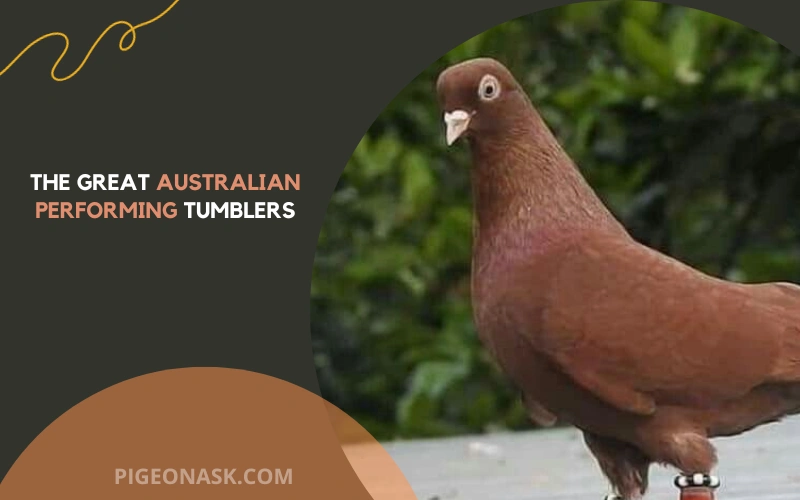
Read on if you want to know the origin and history, varieties, maintenance and appearance of the beautiful Australian performing tumblers.
Australian Performing Tumbler Pigeon Profile
| Name | Features |
|---|---|
| Scientific Name | Columba livia domestica |
| Common Names | Rollers, tumblers, highflyers |
| Origin | Australia (New South Wales) |
| Size | 7-9 inches (1 ft approx..) |
| Weight | 2-3 lbs. |
| Lifespan | 1. Domestic: 15-20 years 2. Wild: 3-5 years |
| Physical Features | Medium-sized and round body; round head and short beak and tail; markings on wings; red, kite, almond, etc. colored feathers |
| Temperament | Calm and gentle |
| Behaviors | Loyal and can make bonds with owners; very social; mate for life; protective of their flocks; investigative |
| Special Features | Can tumble (somersaults) mid air |
| Breeding & Maintenance | Breed twice a year; Clean loft with lime water before breeding; give nutritious food |
| Common or Popular Varieties | No sub-breeds of Australian Performing Tumblers |
Interested in similar topics on pigeon breed:
Overview
The Australian performing tumbler is a fancy pigeon breed from the rock dove. They are also known as rollers and highflyers among the general people.
However, there are some distinctions between the three. Solely based on the tumbling ability, it can be stated that highflyers can tumble but less than tumblers and rollers; rather, their specialty is high endurance.
On the other hand, the rollers can perform quick and massive tumbles and the tumblers do a bit less. The tumbling ability has come to be due to excessive breeding and mutation.
Tumblers have been a popular choice of pets for a long time. The Mughal emperors owned many tumblers along with other fancy pigeon breeds and enjoyed their tumbling and rolling.
In this modern era, they are mainly bred for exhibition purposes. A few people prefer owning them as pets and flying them occasionally. Still, the number is insignificant compared to exhibition tumblers.
Australian Performing Tumblers are known to look a lot like English Long-Faced Tumblers. These are gorgeous birds with medium-sized round heads and pearly eyes. The shape of this breed is rounded in general.
History And Origins of Australian Performing Tumbler Pigeons
The Australian performing tumblers are native to Australia, especially in the states of New South Wales and Queensland.
Their ancestors, some original tumbler breeds, were imported to Australia and the breeders meticulously started selectively crossbreeding and subsequently created this beautiful bird.
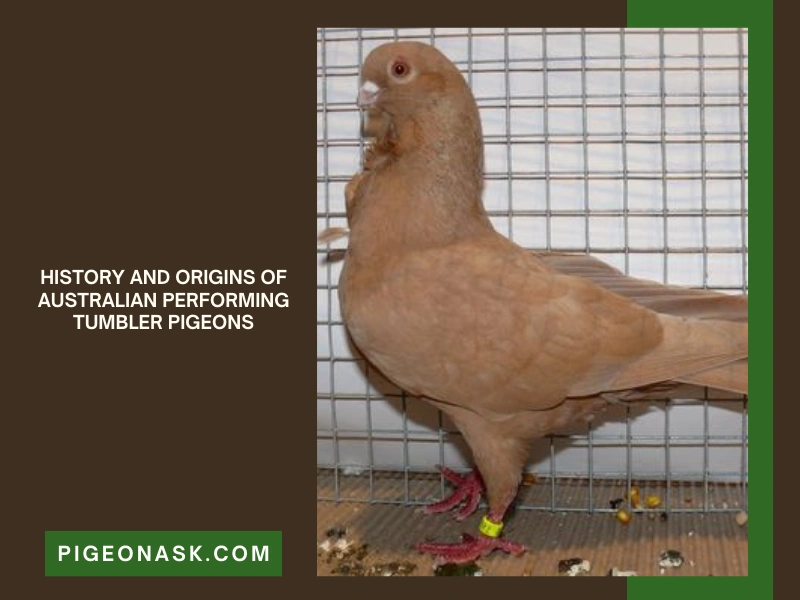
Historians believe the APT was first developed for the show pen in New South Wales. Where they would fly and intermittently perform backward somersaults and fall and obviously, the breed rapidly grew popular.
Currently, breeders raise them mainly for exhibition purposes, not for flying purposes, as the continuous tumbling can severely injure the birds. However, there is a small portion who still fly or own the APTs as pets.
How They Were Bred and Developed?
The organizers of the show pen were looking for a new fancy pigeon breed for exhibition purposes. So, what they did was import tumbler pigeon stocks from around the globe and started carefully crossbreeding with some end goals in mind.
After many trials and errors, they developed the legendary Australian Performing Tumblers, possessing a nice round head and short, thick body.
These birds came in gorgeous red and almond colors and were beautiful in every possible aspect. As a result, they quickly gained popularity among pigeon enthusiasts, first in Australia and then the rest of the world.
These birds are selling at a lucrative 50 to 100 dollars and more nowadays.
Physical Characteristics And Features
As mentioned earlier, the physical characteristics of APT matches with English Long Face Tumblers, but there are distinctive physical characteristics that sets them apart. Have a look
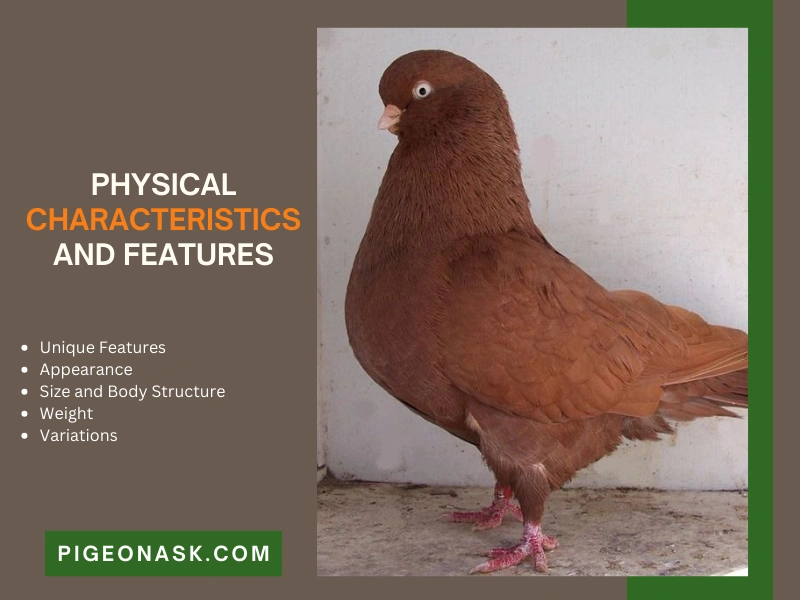
Unique Features
Their fan-shaped tails are small and not stretched like other fancy pigeon breeds like the Fantails. Another notable trait of their tails is that they don’t reach the ground when the pigeon is standing. This breed has tiny beaks and pearly eyes.
Appearance
Australian performing tumblers are medium-sized, round and thick. Their heads are also rounded. The breed comes in various colors and feather patterns.
Their legs are small, red-colored and usually possess no feathers. The breed generally looks elegant and royal, which is why they are majorly used for exhibition.
Size and Body Structure
The apt is a medium-sized thick bird with a round body. This breed can have a height of 7 to 9 inches if measured from the head to the very bottom of its legs.
Weight
The weight of Australian Performing Tumblers is larger than the average weight of other fancy breeds. An adult apt can weigh up to 2 pounds (900 grams) on average. Some can even grow bigger and reach almost 3 pounds (1200 grams).
Variations
Australian Performing Tumblers come in various colors, such as red, kite, almond, etc. This breed has smooth feathers that are snugly tight. Some have white checks on their wings and some have markings on their head, making this breed diverse.
Distribution And Habitat
Australian Performing Tumblers are primarily bred in Australia and have gained popularity among pigeon enthusiasts in regions such as Europe and the Middle East.
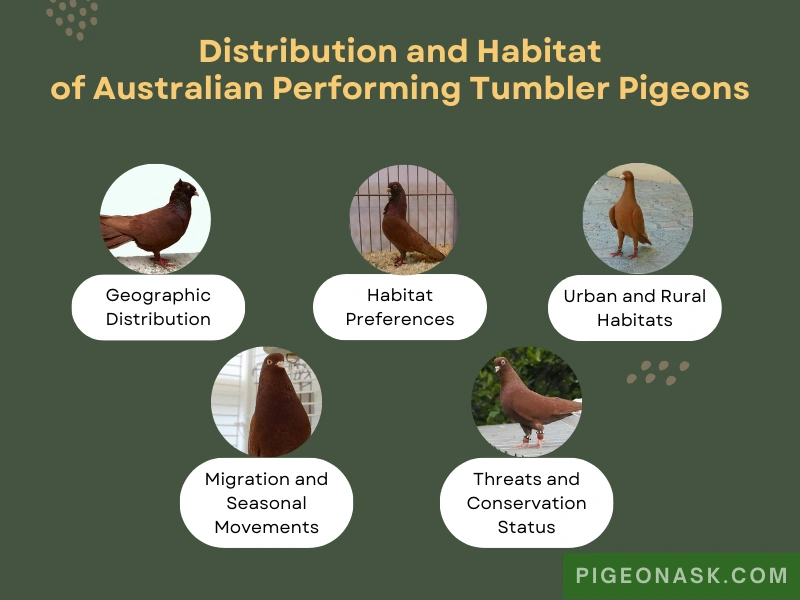
They thrive in dovecotes, adapt well to urban and rural environments, and do not exhibit migratory behavior. This domestic pigeon breed is not considered endangered. Have a look –
Geographic Distribution
Australian performing tumblers were developed in Australia first. Soon after their inception, the breed became a popular flying breed among fanciers worldwide.
You can mainly find this bird among all breeders in the Australian states of New South Wales and Queensland. Moreover, the bird is sporadically available in some parts of Europe, the Middle East, the US and South Asia.
Habitat Preferences
Since the Australian Performing Tumblers are a domestic breed, they live in a manmade structure called a dovecote, a small house with holes for the birds.
Pigeons prefer someplace clean, dry and near food and water sources.
Furthermore, they are territorial, so they like their habitats to be someplace safe and above the ground.
Urban and Rural Habitats
Feral Australian Performing Tumblers, not many in number, can live either in urban or rural areas. Pigeons have grown accustomed to humans and aren’t afraid to live near them. Moreover, they prefer living near humans as it means an effortless supply of food, water and nest-building materials.
In the urban areas, they build their nests, air vents, windows, rooftops, bridges, etc.
And in the countryside, they live in abandoned houses, barns, trees and anywhere close to residence.
Migration and Seasonal Movements
Pigeons generally aren’t migratory birds. Wild ones may move around searching for food and supplies, but it’s not long-term. And the domestic ones rarely leave their dovecotes and nests. The Australian Performing Tumblers are also the same.
Winter and food scarcity apparently doesn’t bother them enough to fly to another part of the world. And why would it, as the shortage doesn’t affect them?
Threats and Conservation Status
Australian Performing Tumblers are an epidemic in Australia and can be found in some parts of the world. They aren’t endangered nor under any threat of going extinct.
Behavior And Traits of Australian Performing Tumbler Pigeons
Australian Performing Tumbler Pigeons are intelligent, loyal, and social pets. They differ from wild pigeons, enjoying a diet of seeds and grains.
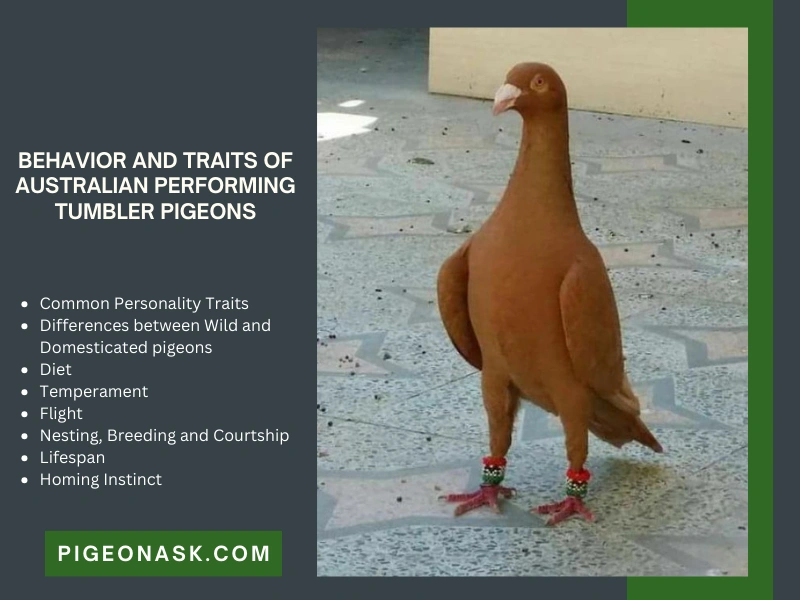
Plus, they’re gentle and territorial, known for their unique backward somersaults during flight. In the following discussion, we’ll explore their care and more.
Common Personality Traits
Like other fancy pigeon breeds, Australian performing tumblers are intelligent and loyal. They are known to form strong bonds with their owners.
Moreover, they can remember people’s faces and recognize a long period of estrangement. Tumblers are adventurous and curious. Also, they are very sociable and enjoy playing with flock members.
Differences between Wild and Domesticated pigeons
Wild and domestic pigeons can differ significantly, even though the wild ones are the ancestors of fancy pigeons.
- Wild ones can survive on their own due to having good survival instincts; the domesticated ones cannot, as they lose some of their instincts because of heavy crossbreeding and learned dependence on humans.
- Wild pigeons are hostile toward humans and other animals, but the domestic ones aren’t.
- Wild ones aren’t special-looking, whereas the fancy ones, well, look fancy and unique.
Diet
Fancy pigeon breeds live under human care and typically subsist on store-bought feeds (a mixture of seeds and grains). Owners can give their Australian Performing Tumblers fruits, vegetables, pearl millet, barley, etc.
Finally, fancy pigeons aren’t that picky about food. You can choose any pigeon feed, grain, or seed and they will most likely devour it. And you are also advised to provide grit (grains and small pebbles) to facilitate their digestion.
Temperament
Australian Performing Tumblers are gentle and calm. They are very friendly and loyal to humans. Tumblers are not aggressive toward other pigeon breeds and animals.
However, being very territorial, they can become quite aggressive toward intruders if they feel threatened.
Flight
Before taking flight, they flap their wings real fast and loud and then ascend to the sky. They do not take off in a straight line, as some might guess. Instead, they fly up in a spiral, which helps them gain altitude.
After ascending, depending on training, instincts and age, they will sporadically tumble. Sometimes, they may hit an object while rolling, which can be life-threatening. Some tumblers have lost their flying ability after facing an accident.
Nesting, Breeding and Courtship
Australian Performing Tumblers don’t have to build nests as they usually live under humans’ care. That said, fancy pigeons build nests high above the ground and in dry places.
They also make sure the spot is safe from predators. Their typical nesting grounds of choice are window creeks, ledges, attics, abandoned houses, barns, etc.
Pigeons build nests with whatever material they can collect, ranging from twigs to straws, leaves to papers and pine needles to roots.
Lifespan
A domestic fancy pigeon, with proper care, they can even live up to 15 years. Some have lived up to 30 years even.
However, the feral ones are not that lucky. Without medications, vaccines and a proper balanced diet and water, they can survive 3-5 years in the wild.
Homing Instinct
Australian Performing Tumblers do not possess a homing instinct. This is an ability held by another fancy pigeon known as the Homing pigeon.
Breeds such as American Racing Homer, Belgian Homer, etc., are some of the Homing pigeons.
That said, Australian Performing Tumblers do possess a unique skill: doing backward somersaults during flight.
Breeding And Maintenance
If you plan to raise and breed Australian performing tumblers, you should know that raising pigeons is not easy. It’s a 24/7 job, 365 days a year. Although pigeons are relatively easy to care for, you must attend to them daily.
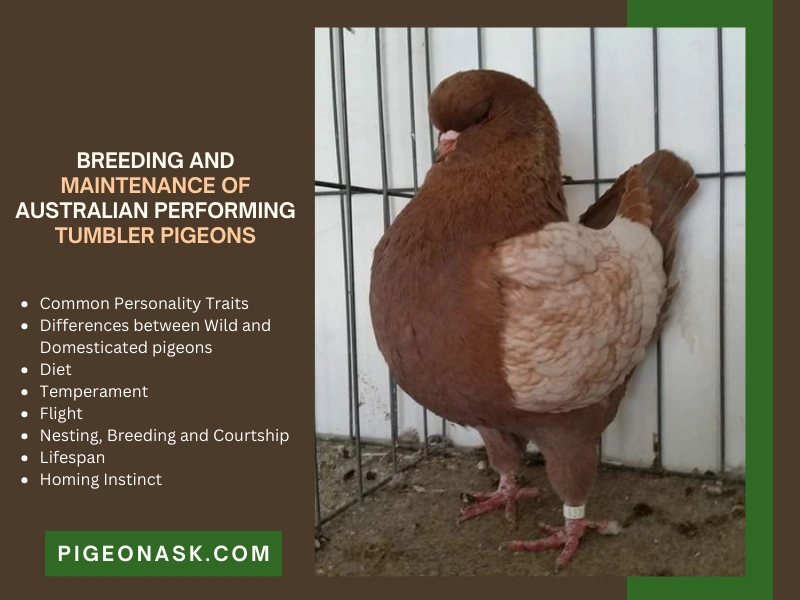
You have to be careful about their housing arrangement, meaning reviewing if they are up to the mark, free from insects, clean and dry.
Secondly, you must be vigilant about viral outbreaks and other diseases, inspecting your pigeons individually to see if they exhibit any signs of infection and ensuring they receive the required vaccines.
And finally, their diet has to be carefully curated. You must ensure your tumblers get all the nutrients by giving them healthy and nutritious foods.
Some Tips and Considerations for Successful Breeding
Tumblers need proper care for successful breeding regarding their housing, feed, health care, etc. Below are some tips for you.
- Pair your tumbler with a no-tumbling one. It ensures fine younglings with stable flying capabilities. And always pair the best ones together.
- A proper diet is a must for successful breeding. Give your pigeons seeds, grains and fruits. You can find pigeon feeds in pet shops.
- Some feed their breeding birds twice with peas, barley and a hint of hemp seeds for a successful breeding process.
- You shouldn’t feed them unhealthy foods such as dairy products, sugar, gluten, chocolate, etc.
- Feed your pigeons Epsom salt, rue tea and crushed mortar during the breeding season to keep them healthy.
- The hen becomes weak before laying eggs due to a lack of calcium and vitamins. So, provide the hen with diets that are rich in these nutrients.
- Make sure they have access to fresh water 24/7.
- Clean their nests with lime water before breeding season to eliminate insects and microorganisms.
Feeding and Housing Requirements
Australian Performing Tumblers pigeons require a suitable living environment for successful breeding. They are, in fact, rather particular about their habitats.
The loft has to be secure, clean and dry. Moreover, the size of the loft can’t be small. The rule of thumb about the size is 7 square feet. Furthermore, it must have proper ventilation and be exposed to sunlight.
The nest boxes must be clear of insects and pathogens. So, make sure you clean them regularly. Experts suggest cleaning the loft with lime water; it’s effective and cheap.
Tumblers must eat at least twice a day. Give them proper diets rich with nutrients. Although pigeons love sugar, don’t indulge them with white poison if you want your birds to be healthy.
Some tumblers have small beaks. Avoid giving them and younglings large seeds and grains such as chickpeas, sunflower seeds, etc.
Final Word
We have reached the end of our article. Hopefully, you have enjoyed reading this and learning more about the beautiful breed as we have enjoyed wording it.
Our intention was to give a brief idea of the great Australian Performing Tumblers’ origin, history, breeding process, diets, personality, appearance, exceptional skill, variations and finally, some tips regarding successful breeding.
In all modesty, we believe to have painted a decent picture for you. If you intend to raise and breed the APT, keep our tips in mind and you will do fine. Good luck!
